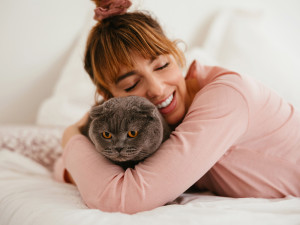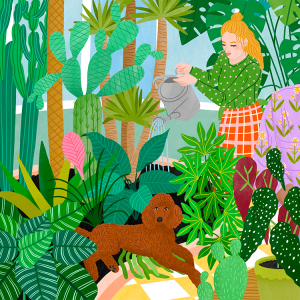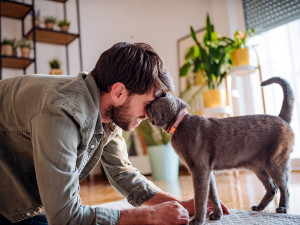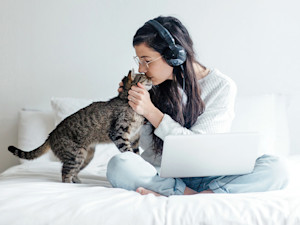Cats Have the Same 4 Attachment Styles as People, Study Says
Is your kitty securely attached? Or are they more the avoidant type?

Share Article
If you’ve spent any time flipping through self-help books, unpacking your past in therapy, or scrolling through dating profiles in 2025, you’ve probably heard of attachment styles. Attachment theory popped up in the 1950s, when a psychiatrist suggested that people form one of four different styles of attachment during their childhoods. There’s secure attachment (hint: you want this one) and three kinds of insecure attachment — anxious, avoidant, or disorganized (we’ll get to these later). And, as is often the case, humans aren’t as uniqueopens in a new tab as we like to think we are. A study publishedopens in a new tab in Current Biology found that cats also have attachment styles that are similar to ours.
What are the attachment styles?
According to the Cleveland Clinic,opens in a new tab in humans, secure attachment is the ideal; it means you’re comfortable with both intimacy and independence, able to trust others, and able to express emotional needs. Yes, these people exist, despite what your Hinge scrolling might be telling you.
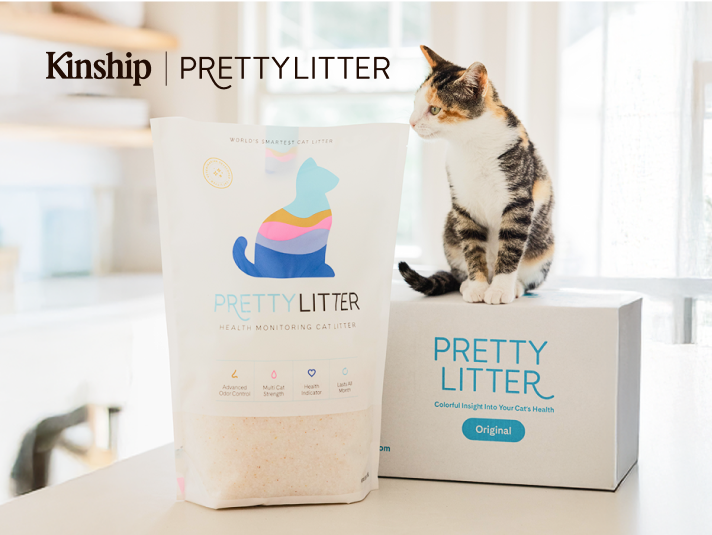
Save on the litter with color-changing tech that helps you better care for your cat.
Insecure attachment comes in a variety of styles (“All happy families are alike….” as the Tolstoy quote goes). People with an anxious attachment style (also called “ambivalent” attachment) experience insecurity and fear of abandonment, sometimes because of inconsistent parenting. Avoidant attachment is characterized by a discomfort with emotional vulnerability and a desire to be completely independent. Disorganized attachment manifests as unpredictable behavior in relationships, such as alternating between clinginess and aloofness or being unable to regulate emotions — the Geminiopens in a new tab of attachment styles.
Researchers have found that attachment styles show up similarly in cats. “I have assessed the attachment styles of over 100 cats,” Kristyn Vitale, a co-author of the study, tells Kinship. “From this research, I have seen that although each cat has its own distinct personality, the way that attachment styles manifest is consistent with the styles we see in human infants and pet dogs with the existence of both secure and insecure attachments to pet parents.”
Study results
In the past, infants have been given a “secure base test” to establish their attachment styles. Depending on how they behave when they’re separated and reunited with their caregiver, scientists have classified them according to the four options.
Researchers gave cats this same test; the pets were observed in a room with their pet parent for two minutes, followed by two minutes alone, and concluding with a two minute reunion phase. They observed a variety of factors, including separation distress, vocalization, and proximity seeking — because cats can’t exactly send an “I’m just not ready for commitment” text.
Cats with secure attachment greet their pet parents upon reunion but return to normal behaviors shortly after. Avoidantly attached cats stay away from their caregivers; they also show less separation distress and meow less when their caregivers are out of the room. Anxiously attached cats remain glued to their pet parent’s side or on their lap, rather than comfortably exploring the room.
First, they conducted the tests on 70 kittens between three to eight months old. The kitties didn’t split evenly into the four categories. Believe it or not, 64 percent of cats were categorized as securely attached. Of the insecurely attached cats, 84 percent were anxious/ambivalent, 12 percent were avoidant, and four percent were disorganized.
They then observed 38 cats over the age of one. The results were similar: 66 percent of cats had a secure attachment style, and 34 percent had an insecure attachment style. These numbers are incredibly similar to those of infants in previous studiesopens in a new tab — according to the U.S. Department of Health and Human Services, 65 percent of infants have secure attachment styles, and 35 percent have insecure attachment styles. Maybe it’s not so wild to consider a cat your child,opens in a new tab after all.
Why it matters
If you ask Vitale — and she’s the expert — research into cats and attachment styles is good for pets and people alike. She adds that this study wasn’t the last to explore the subject — since its publication, multiple papers have used the Secure Base Test to analyze cats’ attachment styles, including one which found that cats with secure attachment styles receive a boost in oxytocinopens in a new tab after cuddling with humans. “Learning about a cat’s attachment style can help you better understand your individual cat’s needs,” Vitale says. “Securely and insecurely attached cats handle stress differently. To be a better pet parent, people should recognize that cats with different attachment styles have different needs.”
For example, she explains that insecurely attached cats take a longer amount of time to calm down after getting stressed out. Knowing this ahead of time allows you to make accommodations that improve your cat’s wellbeing, such as introducing guests to cats slowly.
Vitale notes that, as with humans, anxious or avoidantly attached cats aren’t necessarily less loving. It all comes down to how they deal with change and separation. “It is important to remember that both secure and insecure cats are attached to their caregivers, it is just that their attachment differs in their ability to cope with new situations and stressful events,” she says. “If you have a cat who is securely attached, that cat can utilize their pet parent as a source of comfort and security to relax. If you have a cat who is insecurely attached, that cat is not able to use their pet parent as a secure base and will display persistent distress when presented with a stressor.”
Whatever your cat’s attachment style, Vitale adds that what’s important is paying attention to your pet and respecting their needs. “Whether a person has a secure or an insecurely attached cat, the role of the pet parent is to be emotionally available and empathetic to their cat,” she says.
You don’t need any fancy test to know what’s best for your pet. Just stay tuned to their preferences and keep doing what you’re doing: giving them a happy, love-filled life.

Sio Hornbuckle
Sio Hornbuckle is a writer living in New York City with their cat, Toni Collette.
Related articles
![Woman petting her brown and white cat on the couch.]() opens in a new tab
opens in a new tabDoes Your Attachment Style Affect How You Are as a Pet Parent?
You know you’ve wondered this...
![A woman smiling and hugging her cat on a bed.]() opens in a new tab
opens in a new tabBeing a Neurotic Pet Parent is a Good Thing, Study Says
“Cat ladies aren’t crazy, they’re just anxious...and that anxiousness is associated with trust and affection for a cat.”
![Bodil Jane illustration, someone waters a garden with a brown dog in it]() opens in a new tab
opens in a new tabNature vs. Nurture: Does Your Parenting Style Influence Your Pet’s Behavior?
Your personality may actually have something to do with your pet’s personality.
![Woman snuggling her gray cat at home.]() opens in a new tab
opens in a new tabHave a Big Ol’ Case of Anxiety? Studies Say a Cat Can Help
Believe it or not, that little ball of energy is actually your answer to stress relief.
![Man cuddling his gray cat.]() opens in a new tab
opens in a new tabDoes Your Cat Think You’re Their Mom?
You love them like a child, but is the feeling mutual?
![Woman snuggling her striped gray cat at home.]() opens in a new tab
opens in a new tabCats Release Oxytocin When Cuddling With Humans—But Only on Their Own Terms
It all comes down to attachment styles.



